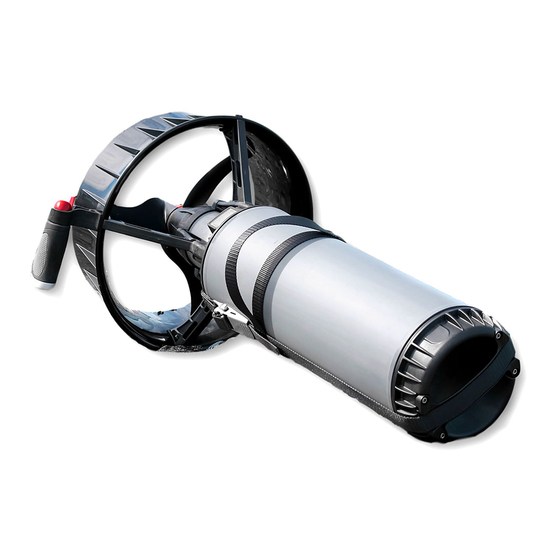
Advertisement
Table of Contents
- 1 Table of Contents
- 2 Cautions & Warnings
- 3 Specifications
- 4 Basic Scooter Components
- 5 Batteries
- 6 Assembly
- 7 Operation
- 8 Dive Planning
- 9 Scooter Failures
- 10 Post-Dive Procedures
- 11 Travel & Storage
- 12 Maintenance
- 13 Spare Parts
- 14 Troubleshooting
- 15 Compliance
- 16 Warranty & Returns
- Download this manual
1
Dive Xtras DPV User Manual
06/02/2020 (Version 1.2)
Models Covered: DX-004-1X000
General Description
The Dive Xtras DPV series is range of underwater tow behind diver propulsion
vehicles designed to enhance a diver's underwater experience. This owner's
manual is not a training manual and should not be substituted for a proper
training course. It is the diver's personal responsibility to seek proper training
in the use of their DPV and to dive within the limits of their training,
experience and DPV as described in the specification.
Original Instructions
Advertisement
Table of Contents

Summarization of Contents
Cautions & Warnings
User Training and Responsibility
Always seek proper DPV and dive training prior to using any DPV. Dive Xtras is not liable for injury or death.
Critical Operational Safety
Warnings include no continuous surface operation, no ascending pull, no DPV-induced risk, propeller hazards, and electrical safety.
DPV Limitations and Handling
DPV is not a toy or rescue tool, not for children. Handle with care and remove batteries when not in use.
Performance Metrics
Details sound levels (<= 70 dB(A)) and vibration levels (<= 2.5 m/s²) during operation.
Specifications
BlackTip Travel Specifications
Details weight, length, depth rating, continuous and boost speeds, runtime, and thrust for the Travel model.
BlackTip Tech Specifications
Details weight, length, depth rating, continuous and boost speeds, runtime, and thrust for the Tech model.
BlackTip Exploration Specifications
Details weight, length, depth rating, continuous and boost speeds, runtime, and thrust for the Exploration model.
Basic Scooter Components
Component Identification
Identifies key external and internal components of the DPV, including motor, battery, and controls.
Batteries
Battery Compatibility
DPV accepts DCB-type power tool batteries (20v Max/18v XR), 5Ah to 12Ah. Batteries must match in age and capacity.
Battery Charging Procedures
Always fully charge batteries before installing. Charge close to dive time; never store batteries inside the scooter.
Scooter Battery Performance
Details runtime and range for 5Ah and 12Ah batteries at cruise speed.
Assembly
Installing Batteries
Steps to loosen strap, remove nose cone, insert batteries, and replace nose cone and strap.
Using the Tow-Cord Attachment
Importance of tow cord for thrust transmission and how to attach it securely to gear.
Operation
Operating Your DPV
Control DPV with double/single clicks on thumb trigger for speed changes and stopping.
Safe Start Feature
DPV spins slowly at low power before cruise speed to prevent accidents in air or obstructions.
Buoyancy and Trim Adjustment
Adjust buoyancy by adding/removing weight from nose pockets. DPV floats nose up when stowed.
Speed Modes and Migrate
DPV has 8 speeds; migrate feature returns to speed 3 if stopped for over five seconds.
Dive Planning
Distance and Runtime Planning
Plan for DPV's long travel capability. Calculate max runtimes empirically with safety margins.
Scooter Failures
Flooding Procedures
If DPV floods, unclip and release it for safety. Flooding can make it negative and a risk.
Flood Recovery Steps
Details two flood types: minor (workable) and bad (smoking/hot batteries, requiring submersion).
Flood Recovery Instructions A-D
Specific steps for drying and checking DPV after minor or major water ingress.
DPV Fails to Run
Options if DPV stops running: swim with it, get towed, or release it.
DPV Won't Stop Running
Lever Off Trigger
Apply opposing force to the trigger to move it to the 'Off' position if stuck.
Grabbing the Propeller
Safely grab the propeller to stop it due to the Safe Start system.
Reduce Thrust
Pull propeller assembly into body to restrict inlet flow and reduce thrust.
Release DPV if Unsafe
If other methods are unsuitable or risky, unclip and release the DPV.
Post-Dive Procedures
Rinsing, Drying, and Battery Removal
Rinse scooter, run briefly, dry thoroughly, remove batteries, and store in a warm, dry location.
Travel & Storage
Packing for Travel
Separate DPV body from tail. Protect tail/propeller area. Store body with or without nose cone.
Battery Travel Protocols
TSA rules for batteries: protect terminals, use plastic bags, or travel clips. Check airline policies.
Maintenance
Battery Removal
Remove batteries from the DPV prior to any maintenance activity.
Routine Component Maintenance
Maintain O-rings, propellers, and thumb triggers for optimal performance and longevity.
Shroud Removal
Shroud removal is only for Dive Xtras maintenance personnel during a DPV overhaul.
Troubleshooting
Troubleshooting Battery Mismatch
LED error '1' or '2' indicates battery mismatch. Ensure both batteries are fully charged.
Compliance
CE Approval
DPV models conform to European Machinery & EMC Directives for diving to 80m.
RoHS Statement
DPV models comply with EU Directive on restriction of hazardous substances.
WEEE Compliance
DPV meets WEEE directive for reduced EEE waste; EU products marked with symbol.
Disposal of Electrical and Electronic Waste
Return EEE waste to appropriate company for recycling or use local disposal options.
EC Declaration of Conformity
Supplier Information
Identifies Dive Xtras Inc. and responsible person for the declaration.
Product Description
Declares conformity for Battery powered Diver Propulsion Vehicle (DPV), Model: BlackTip DPV, DX-004-1X000.
Conforming Directives and Standards
Lists directives and standards the DPV complies with.
Warranty & Returns
Standard Warranty Terms
Limited 1-year warranty against defects, with exceptions for flood, batteries, and cosmetic issues.
Return & Replacement Policy
Merchandise requires RMA. Returns evaluated for warranty. Unauthorized returns incur restocking fees.


Need help?
Do you have a question about the BlackTip Tech and is the answer not in the manual?
Questions and answers